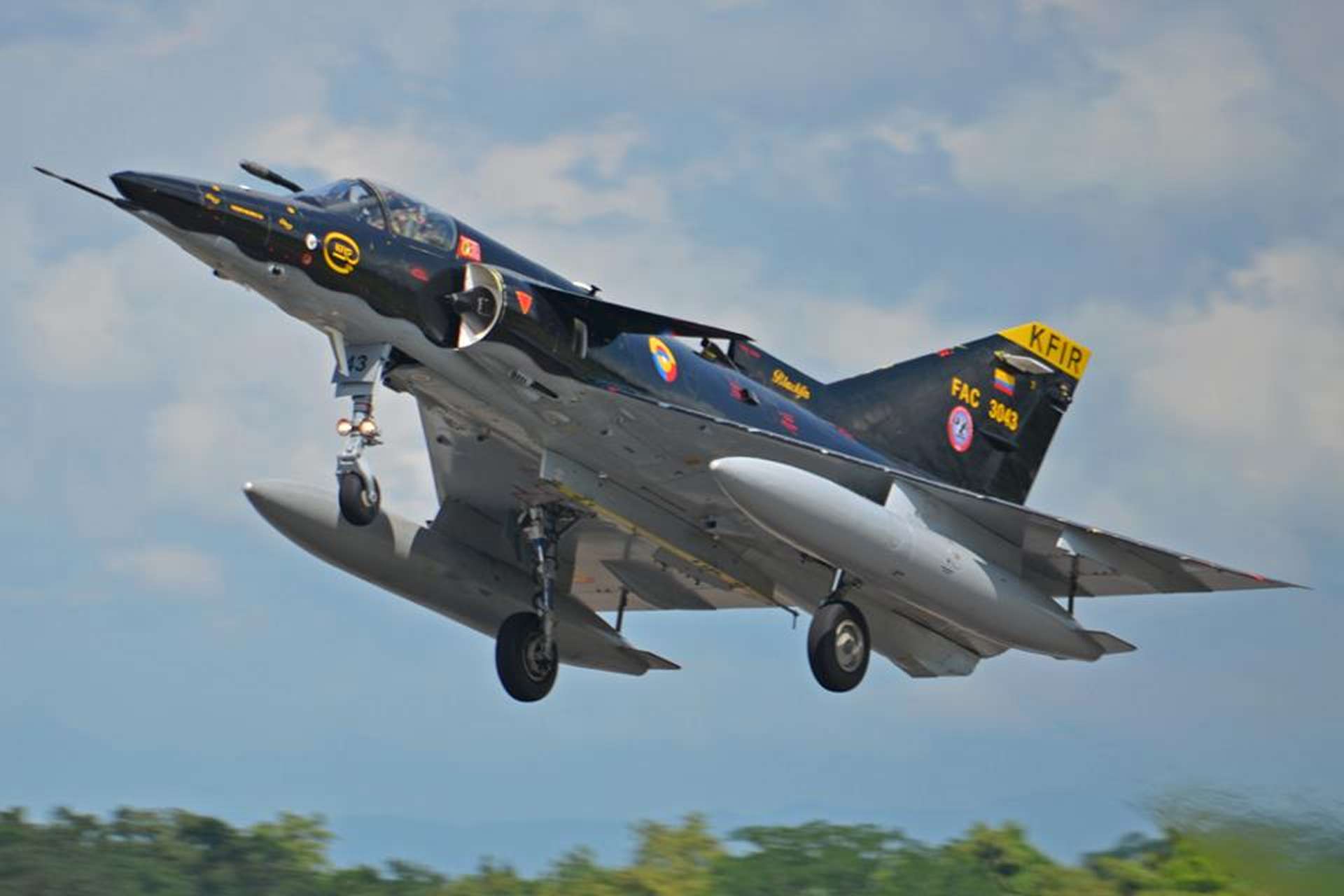Colombia Signs New Defense Contract with Israel for Kfir Aircraft

{loadposition bannertop}
{loadposition sidebarpub}
In contrast to previous statements by Colombian President Gustavo Petro regarding the suspension of defense and security relations with Israel, the Colombian government has finally concluded a new contract with Israel Aerospace Industries (IAI) for the maintenance of its Kfir fighter aircraft fleet. Infodefensa reported This on February 3, 2025.
Follow Army Recognition on Google News at this link
The Kfir is a fighter aircraft developed by Israel Aerospace Industries based on the Dassault Mirage 5 and the IAI Nesher. (Picture source: Colombian MoD)
According to information obtained from specialized sources, the agreement—officially listed under contract number 260-00-A-Cofac-Codaf-2024—amounts to USD 7.2 million. It took effect on December 27, 2024, and will remain valid until July 30, 2026.
Under this agreement, IAI will provide scheduled and unscheduled maintenance services for the Colombian Air Force’s (FAC) Kfir C10/12 COA aircraft. The FAC will deploy a team of 44 specialized technicians from Combat Air Command No. 1, covering various fields of expertise such as airframes, armament, engines, avionics, electronics, and overall planning.
Currently, the FAC has 11 operational Kfir aircraft (nine in flight status and two under maintenance), supported by 27 General Electric J-79J1EQD engines (11 installed and 16 in maintenance). The operational availability of these airframes and engines remains crucial for the FAC’s ability to project air power and meet its national security needs.
The Kfir is a fighter aircraft developed by Israel Aerospace Industries (IAI) based on the Dassault Mirage 5 and the IAI Nesher, with its first flight on October 19, 1970. Designed to meet the needs of the Israeli Air Force, it officially entered service in 1975 and was retired from service in Israel in 1996. However, it continues to operate with several foreign air forces, including in Colombia, where it remains in service beyond the 2020s. The Kfir stands out for its single-seat configuration, its General Electric J79 afterburning turbofan (producing 83.4 kN of thrust with afterburner), and its supersonic flight capabilities, allowing it to reach a top speed of 2,440 km/h and an operational ceiling of 17,700 meters. Its climb rate of 13,980 meters per minute, combined with a load factor that can reach 7.5 g, reflects its excellent maneuverability.
Structurally, the Kfir has a wingspan of 8.21 meters and a length of 15.65 meters, with a height of 4.55 meters and a wing area of approximately 34.80 square meters. Its empty weight is 7,285 kg, rising to 10,415 kg when armed and reaching a maximum of 14,670 kg. It can carry a variety of offensive and defensive payloads, up to a maximum of 6,085 kg of external armament, in addition to two 30 mm DEFA 553 cannons mounted in the fuselage. It also has a range of about 770 km, making it versatile enough for interception or attack missions. A total of 2,121 units of this aircraft were built, making the Kfir an important player in the history of Israeli fighter aviation and a major asset for several air forces worldwide.
Despite President Petro’s earlier stance suggesting an end to contracts with Israeli companies, the FAC proceeded with finalizing this agreement. Analysts note that longstanding cooperation with Israel remains a key pillar of Colombia’s defense and intelligence capabilities, indicating a practical continuity of bilateral ties despite certain political positions.
Originally developed by Israel from a Mirage airframe, the Kfir has for decades been the cornerstone of the FAC’s supersonic fleet. This new contract illustrates Colombia’s determination to keep its main fighter aircraft in optimal service condition, ensuring robust air defense and counterinsurgency capabilities for the country.

{loadposition bannertop}
{loadposition sidebarpub}
In contrast to previous statements by Colombian President Gustavo Petro regarding the suspension of defense and security relations with Israel, the Colombian government has finally concluded a new contract with Israel Aerospace Industries (IAI) for the maintenance of its Kfir fighter aircraft fleet. Infodefensa reported This on February 3, 2025.
The Kfir is a fighter aircraft developed by Israel Aerospace Industries based on the Dassault Mirage 5 and the IAI Nesher. (Picture source: Colombian MoD)
According to information obtained from specialized sources, the agreement—officially listed under contract number 260-00-A-Cofac-Codaf-2024—amounts to USD 7.2 million. It took effect on December 27, 2024, and will remain valid until July 30, 2026.
Under this agreement, IAI will provide scheduled and unscheduled maintenance services for the Colombian Air Force’s (FAC) Kfir C10/12 COA aircraft. The FAC will deploy a team of 44 specialized technicians from Combat Air Command No. 1, covering various fields of expertise such as airframes, armament, engines, avionics, electronics, and overall planning.
Currently, the FAC has 11 operational Kfir aircraft (nine in flight status and two under maintenance), supported by 27 General Electric J-79J1EQD engines (11 installed and 16 in maintenance). The operational availability of these airframes and engines remains crucial for the FAC’s ability to project air power and meet its national security needs.
The Kfir is a fighter aircraft developed by Israel Aerospace Industries (IAI) based on the Dassault Mirage 5 and the IAI Nesher, with its first flight on October 19, 1970. Designed to meet the needs of the Israeli Air Force, it officially entered service in 1975 and was retired from service in Israel in 1996. However, it continues to operate with several foreign air forces, including in Colombia, where it remains in service beyond the 2020s. The Kfir stands out for its single-seat configuration, its General Electric J79 afterburning turbofan (producing 83.4 kN of thrust with afterburner), and its supersonic flight capabilities, allowing it to reach a top speed of 2,440 km/h and an operational ceiling of 17,700 meters. Its climb rate of 13,980 meters per minute, combined with a load factor that can reach 7.5 g, reflects its excellent maneuverability.
Structurally, the Kfir has a wingspan of 8.21 meters and a length of 15.65 meters, with a height of 4.55 meters and a wing area of approximately 34.80 square meters. Its empty weight is 7,285 kg, rising to 10,415 kg when armed and reaching a maximum of 14,670 kg. It can carry a variety of offensive and defensive payloads, up to a maximum of 6,085 kg of external armament, in addition to two 30 mm DEFA 553 cannons mounted in the fuselage. It also has a range of about 770 km, making it versatile enough for interception or attack missions. A total of 2,121 units of this aircraft were built, making the Kfir an important player in the history of Israeli fighter aviation and a major asset for several air forces worldwide.
Despite President Petro’s earlier stance suggesting an end to contracts with Israeli companies, the FAC proceeded with finalizing this agreement. Analysts note that longstanding cooperation with Israel remains a key pillar of Colombia’s defense and intelligence capabilities, indicating a practical continuity of bilateral ties despite certain political positions.
Originally developed by Israel from a Mirage airframe, the Kfir has for decades been the cornerstone of the FAC’s supersonic fleet. This new contract illustrates Colombia’s determination to keep its main fighter aircraft in optimal service condition, ensuring robust air defense and counterinsurgency capabilities for the country.




